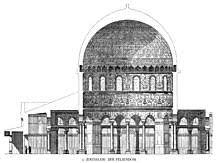During the early Muslim conquests in the 7th century, forces of the Rashidun Caliphate led by Umar ibn al-Khattab conquered the armies of Persia and the Byzantine Empire. They conquered Persia, Mesopotamia, Shaam, Egypt, North Africa, and Spain.
In November 636, the Muslim army seized Jerusalem, which the Byzantine Romans had held. After a four-month siege, the Orthodox Patriarch of Jerusalem, Sophronius, consented to surrender Jerusalem to Caliph Umar personally. In the spring of 637, Caliph Umar of Medina consented to these stipulations and traveled to Jerusalem to sign the capitulation. Sophronius also negotiated the Umariyya Covenant, or Covenant of Omar, with Caliph Umar, guaranteeing Christians religious freedom in exchange for jizyah, a levy levied on conquered non-Muslims known as "dhimmis." The Christian and Jewish populations of Jerusalem experienced the typical tolerance accorded non-Muslim theists during this period of Muslim rule. However, life was not fun or easy for non-Muslims. The Christians and Jews suffered over the several hundred years based on warped interpretations of the Covenant of Omar, during which there were times when the outward display of a faith other than Islam was punished harshly, so Jews with their Tzizit out in the open or even praying with Tefilin in a home but visible through a window opening were in danger and often punished.
This lasted until the Fatimid Dynasty conquered the land and abandoned the Sunni-based Covenant of Omar. During their reign, Jews were left alone; however, there were times when the Covenant was invoked.
The Fatimids were a Shia Islamic dynasty of Arab origin who allegedly traced their ancestry to Muhammad's daughter Fatima and her husband Ali B Abi Talib, who was the first Shi‘ite imam. Between 902 to 909, the foundation of the Fatimid state was set after the Kutama Berbers, a tribe native to Algeria, under the leadership of a Shia missionary named Abu Abdallah, whose conquest of parts of northern Africa, widely believed to be present-day Tunisia, paved the way for the establishment of the Fatimid Caliphate.
The Fatimid dynasty was a Shi'ite dynasty that ruled over northern Africa and the middle east from the 10th to 12th centuries. The Jewish people enjoyed a reasonable degree of tolerance and security during their reign; once they paid their tax, they did not openly pray or walk around showing any signs of their faith. The Fatimid dynasty arose from the efforts of the Shi'a Ismli branch, which aimed to restore the caliphate to the Prophet's direct descendants and combine Islamic religion, which is founded on divine revelation, with Greek philosophy for other religions' beliefs to mix with their own. As a result, followers of this Islamic group were more tolerant. The fact that the vast majority of their Muslim subjects remained loyal to traditional Sunni Islam and antagonistic to the Shi'ite caliphs forced them to select Christian and Jewish thinkers as officials and ministers, which contributed to their liberal attitude toward non-Muslim subjects.
Under their rule, Christians could easily construct new churches and hold solemn processions, which the caliphs themselves often attended. Al-Azz (975–996), Egypt's second Fatimid caliph, nominated two brothers of his Christian wife to the positions of the patriarch of Jerusalem and Alexandria, respectively. While Jews did not achieve such lofty positions, they did enjoy religious liberty, and their civil rights were not restricted.
Al-Hakim, however, the third Caliph, persecuted non-muslims during the latter part of his reign. For various reasons, the Fatimids' economic strategy benefited Jews greatly. The caliphs were interested in increasing trade between Egypt and other countries because they believed it would help them convert more people to their religion. They successfully shifted traffic between India and the Near East from the Persian Gulf to the Red Sea, becoming a major international trade corridor. Because the Fatimids did not create monopolies or punish small merchants and industrialists as other Muslim rulers did, many Jewish merchants of various wealth participated in the Indian trade.
The Fatimids are widely seen as responsible for creating many of the structures that currently exist on the Temple Mount. many of the pre- Crusader monuments on the Temple Mount, what they called the 'Haram Al Sharif' was renovated and rebuilt under the patronage of the Fatimid dynasty. Specifically, the Dome of the Rock, while built-in 691 by the Umayyad caliphate (661-750) as a shrine, was remodeled and expanded to encompass the courtyard that is currently in place in 1035 under the rule of the Fatimids.
If the building of the original Dome was seen as a way to put Islamic facts on Judean ground by covering up the ruins of the Second Temple, the remodel and expansion were seen as means to cover up the area's distinct Jewish past completely. After an earthquake in 1033 had collapsed much of the structures on and near the compound, some of the former Temple structures were visible. The Fatimids, ever concerned with symbolism that could inspire and ignite an uprising by the Christian and Jewish populations, decided to whitewash the entire area, covering it in Islamic iconography and cleansing it of the Judeo and Roman ‘feel’ as if to say, ‘this area is, was and will always be a shrine for the followers of the Prophet Muhammad.’


